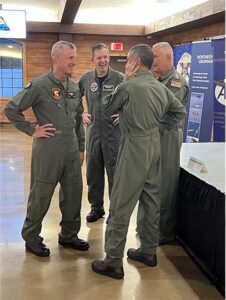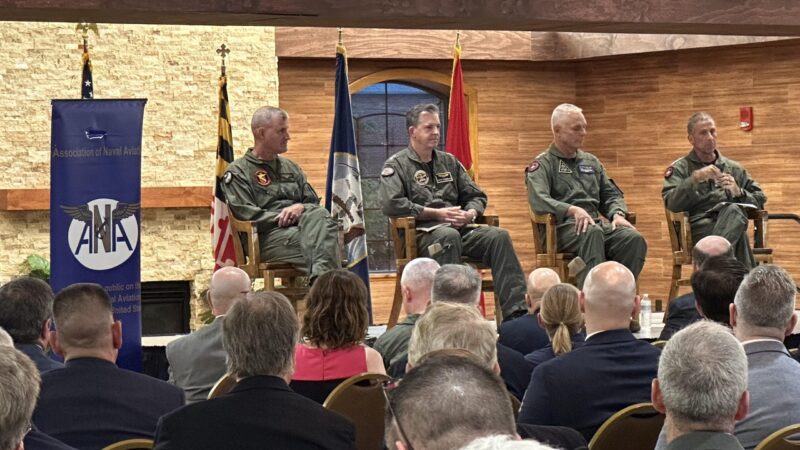
The Patuxent Partnership, Association of Naval Aviation and Marine Corps Aviation Association hosted a Naval Aviation 3-Star Summit in Lexington Park, Maryland. The evening’s theme was “Advancing Naval Aviation Readiness for the High-End Fight.” Panelists included NAVAIR Commander, Vice Adm. Carl Chebi; Commander, Naval Air Forces Pacific, and “Air Boss” Vice Adm. Daniel Cheever; Director, Air Warfare Division (N98) Rear Adm. Buzz Donnelly; and Marine Corps Deputy Commandant for Aviation Lt. Gen. Bradford Gering.
The stars were out for over 200 attendees May 29 at the Naval Aviation 3-Star Summit in Lexington Park, Maryland. The evening’s theme was “Advancing Naval Aviation Readiness for the High-End Fight.”
The event marked the first-time leaders of the Naval Aviation Enterprise, including NAVAIR Commander, Vice Adm. Carl “Chebs” Chebi; Commander, Naval Air Forces Pacific and “Air Boss” Vice Adm. Daniel “Undra” Cheever; Director, Air Warfare Division (N98) Rear Adm. Michael “Buzz” Donnelly; and Marine Corps Deputy Commandant for Aviation Lt. Gen. Bradford “Gilla” Gering gathered for the event, hosted by The Patuxent Partnership, Association of Naval Aviation and Marine Corps Aviation Association.
The panel spent 90 minutes addressing a wide range of questions on topics including recruiting and retention, overcoming budget challenges, joint capability development, accelerating capability delivery, unmanned aviation, increased automation (artificial intelligence and machine learning), and Live Virtual Constructive Training.
Vice Adm. Chebi opened the discussion with an audience question about improvements to the requirements process to help the naval aviation community be a little more flexible.
“I think that is a very specific area we need to look at formally,” replied Adm. Donnelly, director of the Air Warfare Division (N98) at the Pentagon. “There is a recognized shortfall in the speed we need to move with innovation…to take advantage of what industry can do. The current process cannot keep up with the way we are doing things right now.”
Chebi said while it is a “long, laborious process, there’s a lot we can effectively apply within the construct of ‘big R’ requirements to get capability out there now. There are so many authorities and flexibilities we can leverage to increase warfighting capability and the availability of our platforms.”
Air Boss Vice Adm. Cheever then addressed retention and recruiting in naval aviation.
“There are gaps out there. [In the enlisted specialties] we don’t have a lot of young apprentices,” he said. “So they’re not training to become journeymen and supervisors, and the development is a little slower than we’d like right now. In the officer ranks, we’re mitigating department head shortages, as well as junior officer shortages, by assigning temporary duty in key billets. The flexibility and standard of excellence in naval aviation ensures even those who didn’t train with the team, can seamlessly join the team. I’m pulling pros from the bullpen that are really trained and really good.”
From the Marine perspective, Lt. Gen. Gering said, “in aggregate, we’re making our recruiting mission. If you look at our retention goals, we’re making those as well.”
Chebi also asked the panel to discuss budget challenges for Naval and Marine Corps aviation.
“Balancing crisis response with modernization is one of the Commandant’s five priorities,” Gering said. “Crisis response is a must pay bill; we must look for trade space in modernization with a fixed top line.”
Chebi was then asked about new collaboration with the other services in future launch weapons solutions.
Donnelly noted an increased level of cooperation in that arena.
“Coming back into the Pentagon from my previous requirements job… I’m pleased at how close we are cooperating with the Air Force, particularly in weapons. We’ve got a partnership in [long-range and penetrating weapons] as well as air-to-air. With our partnered use of the F-35 Lightning II, the fit, form, and function vis-a-vis weapons carriage and delivery match both our needs.”
Donnelly also emphasized partnership with industry.
“I think our industry partners recognize how much the DoD and the services are investing. That partnership has been very helpful, and it’s also included Congress who has given us some legislative authorities for multi-year procurements.”
An audience member asked the panel the status of a replacement for the Navy and Marine T-45 Goshawk training aircraft.
“It’s not just the airframe replacement of the T-45. It’s a holistic, undergraduate training system,” said Donnelly. “CNATRA is changing its syllabus based on the way people are learning today, adding virtual reality and simulation.” We recognize with the precision landing mode we expect in future fighters… landing on a carrier may not be the most difficult portion of the mission. We can reduce some of the workload we’re putting into carrier landings, freeing up time to focus on more complex tasks such as information processing and decision making. [It] gives us a holistic new way to look at what we will implement and probably some wider options to consider as a T-45 replacement.”
A question on automation prompted Chebi to advocate for more development of AI and ML.
“The smartest folks in the room are not sitting up here. So please provide us your inputs on ways to do this better. My ask of all of you is to show us what the possibilities are from automation, from AI, from ML, so that we can apply them to our programs.”
“I think where automation can really help us is aviation safety,” Gering said. “And I think the other thing we are struggling with is the tyranny of time-distance logistics in the big fight. I think we could use a lot of help there. We need predictive maintenance. It’s all about logistics, fuel and weapons in the high-end fight.
The group later discussed a brief they received via video teleconference with leadership from the deployed Dwight D. Eisenhower Carrier Strike Group.
“My takeaway is, it’s really impressive to see the capability employed today in the Red Sea. We provided that capability by working together toward an outcome that matters – delivering the capability the fleet needs, when they need it, so they can deter, fight, win and return home safely,” Chebi said.
“The operations conducted in the Red Sea validate decades of planning, development, and investment that we’ve gotten out of the fleet,” Donnelly said. “It validates our ability to react very quickly to recognize the gaps and get solutions back immediately to the fleet to give them the advantage we require.”
Billed as a follow-up to the TPP-hosted Defense Summit in March, the 3-Star Summit served to enhance dialog with industry members and educate the public on the importance of naval aviation to national defense.


The Patuxent Partnership, Association of Naval Aviation and Marine Corps Aviation Association hosted a Naval Aviation 3-Star Summit in Lexington Park, Maryland. The evening’s theme was “Advancing Naval Aviation Readiness for the High-End Fight.” Panelists included NAVAIR Commander, Vice Adm. Carl Chebi; Commander, Naval Air Forces Pacific, and “Air Boss” Vice Adm. Daniel Cheever; Director, Air Warfare Division (N98) Rear Adm. Buzz Donnelly; and Marine Corps Deputy Commandant for Aviation Lt. Gen. Bradford Gering.


